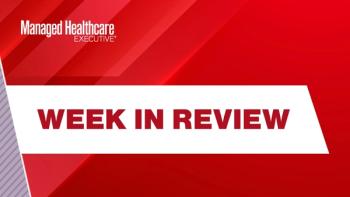
- MHE September 2024
- Volume 34
- Issue 9
Telehealth is a Go, and States Are Having Their Say So
Telehealth has become a permanent part of U.S. healthcare delivery, and states are taking steps to regulate it
Kyle Zebley’s two grandmothers have two very different approaches to technology. “The 96-year-old has had a computer for 30 years, has just in the past year opened up an Instagram account, and is very fluent in terms of digital literacy,” says the American Telemedicine Association’s senior vice president for public policy.
He says his 94-year-old grandmother has never touched a computer keyboard. Instead, the two bond over Turner Classic Movies. He’s her go-to resource when she has movie questions. “I come in like a wizard with my smartphone and start answering all of the questions she’s stored up,” says Zebley.
Not surprisingly, his two grandmothers also have very different relationships with telehealth. His Instagram-using grandmother takes full advantage of the convenience of virtual visits. The other grandmother has no interest in telehealth other than talking to providers by phone.
For Zebley, the digital divide between his grandmothers illustrates how telehealth is — and is not — fully integrated into the healthcare system. On the one hand, if a patient embraces it, telehealth can be a significant way for her to receive healthcare. On the other hand, if a patient is uncomfortable with telehealth, she can usually get the care she needs entirely in person.
Regardless of personal preferences, telehealth is now a permanent part of U.S. healthcare delivery. According to AHIP, the health insurance trade group, more than 40% of mental health visits are now conducted via telemedicine. Yet the rules and realities of the business of telehealth vary widely from state to state, and that hodgepodge may have long-term effects on usage patterns.
Tracing back to COVID-19
The history of telehealth has already been divided into the pre-COVID-19 pandemic period and the postpandemic period. Because of the pandemic, HHS made several regulatory changes designed to expand telehealth access for Medicare recipients. “Prior to that, only a tiny sliver of Medicare beneficiaries — under very rigid, restrictive conditions — had access to telehealth,” Zebley explains.
The HHS pandemic-era waivers set aside several geographic and other restrictions. But the expiration of the federal COVID-19 public health emergency last year meant some of those changes sunsetted whereas others were extended temporarily. The HHS waivers only cover federally administered programs, but Zebley says that when the federal government relaxed its rules, it had a knock-on effect on commercial insurers. States have regulatory power over health insurance. The growing use of telehealth has led some states to take up contentious regulatory questions related to telehealth coverage, including payment parity, exclusivity contracts, and alternative forms of telehealth.
Fair pay
One of the most talked-about issues in the regulatory debate is how virtual visits should be reimbursed compared to in-person visits. It is complicated because replacing in-person care with virtual care shakes up traditional cost structures. Implementing telehealth can be costly, but providers may have lower overhead in the long term. Likewise, patients might be quicker to seek medical attention with the convenience of telehealth, but that can have positive and negative effects.
James Swann, director of communications and public affairs for AHIP, said all those variables underscore the importance of allowing insurers to freely negotiate their agreements with providers and platforms. “Some plans may choose to reimburse providers at the same rate for virtual care as in-person care, but health plans must have the flexibility to design benefits and contract with providers in a way that meets the needs of their members, employers and other purchasers,”he said in an email.
Increasingly, states have moved to restrict that flexibility. Nathaniel Lacktman, J.D., a partner in the national law firm Foley & Lardner LLP and a member of the board of directors of the American Telemedicine Association (ATA), says 33 states now have payment parity laws, compared with just 16 before the pandemic. His firm published a report on state telehealth laws earlier this year. Lacktman says most states do not require all telehealth services to be reimbursed at the full rate for in-person visits. For instance, Nebraska’s parity rule only applies if the provider also provides in-person care in the state. Rhode Island’s rules only apply to in-network primary care, registered dietitians/nutritionists, and behavioral health.
Lacktman says parity laws are important in incentivizing providers to use telehealth. Now that telehealth has hit an inflection point, he says payers and providers can get a more realistic understanding of its costs and benefits. “And once we see that happen, then there’s every reason to have appropriately adjusted reimbursement rates,” he says. “I just don’t think we should be premature with that and disincentivize something that we have collectively said is a good thing.”
Lacktman, chair-elect of the ATA board, says without parity regulations, reimbursement rates can be set arbitrarily. “If you were to set an arbitrary payment rate for telehealth calculated at 50% of the identical service when delivered in person, who benefits from that?” he says. “I would posit that it’s primarily the shareholders of health insurance companies, as opposed to the individual members who pay the premiums or their employers or the providers delivering the services.”
Competition and flexibility
Another point of contention relates to exclusivity contracts between health plans and telehealth providers. Back when there were few telehealth platforms, Lacktman says some platforms entered contracts with health plans to become the plans’ exclusive provider of telehealth services. That meant if a patient’s primary care physician used a telehealth platform different from the health plan’s preferred platform, the patient might have to pay out of pocket to see their physician virtually, even if the physician was in network. Lacktman argues that such restrictions are harmful to patients.
“Because that has an anticompetitive nature, it could result in higher overall rates and lower quality of service,” he says. “And this interrupts the continuity of care for the existing relationships between the primary care provider and the patient.”
In 2019, 15 states had provisions governing narrow or exclusive contracts between health plans and telehealth companies. Since then, six more states have added laws related to such contracts.
Swann at AHIP counters that restricting the flexibility of health plans can also negatively impact patients. “Benefit design flexibility is important because plans provide coverage to different populations across all markets — Medicare Advantage, Medicaid managed care, and commercial coverage. All populations do not necessarily have the same needs, and the purchaser of the coverage also varies; plans need to be responsive to those various needs,” he emailed. He added that flexibility helps payers ensure that appropriate care is provided via telehealth, that such care is coordinated with a patient’s primary care provider, and that the telehealth platforms patients use comply with federal privacy statutes.
Aside from payment issues, states are also reckoning with how to define telehealth. “Audio-only is the oldest example of telehealth,” Zebley says. “I’m sure, within a few years of the widespread adoption of the invention of the telephone, there were plenty of doctors’ calls.”
But before the COVID-19 public health emergency, Medicare and commercial health plans did not generally consider phone calls to be separately payable, the Foley & Lardner report notes. Instead, phone calls were treated as part of the normal previsit or postvisit doctor-patient communication. The pandemic changed that, with Medicare temporarily authorizing separate payment for audio-only care and 18 states subsequently passing permanent changes to that effect.
No in-person equivalent
At the other end of the technological spectrum is new asynchronous technology, such as remote patient monitoring. The report notes that these technologies can create a regulatory challenge because, in many cases, they have no in-person equivalent.
Lacktman says it is too early to know exactly how these newer technologies will fit into the healthcare system but adds that it is important to have a regulatory infrastructure that incentivizes their adoption. “If we refuse to do payment until we can say, ‘Oh, this is clearly going to be great,’ we actually won’t get enough volume to know where it’s clearly great,” he says.
Although remote patient monitoring is still an emerging part of the healthcare industry, all sides agree that telehealth more broadly has become an important — and permanent — part of U.S. healthcare. “We’re always going to have some of these obstacles,” Zebley says, “but we’ve really been able to make huge progress over the last 4 ½ years.”
Articles in this issue
about 1 year ago
AIDS 2024, the 25th International AIDS Conferenceabout 1 year ago
A Conversation With Eric C. Hunter, MBA, CEO of CareOregonabout 1 year ago
Digital Twins Could Be the Crystal Balls of HealthcareNewsletter
Get the latest industry news, event updates, and more from Managed healthcare Executive.

















































